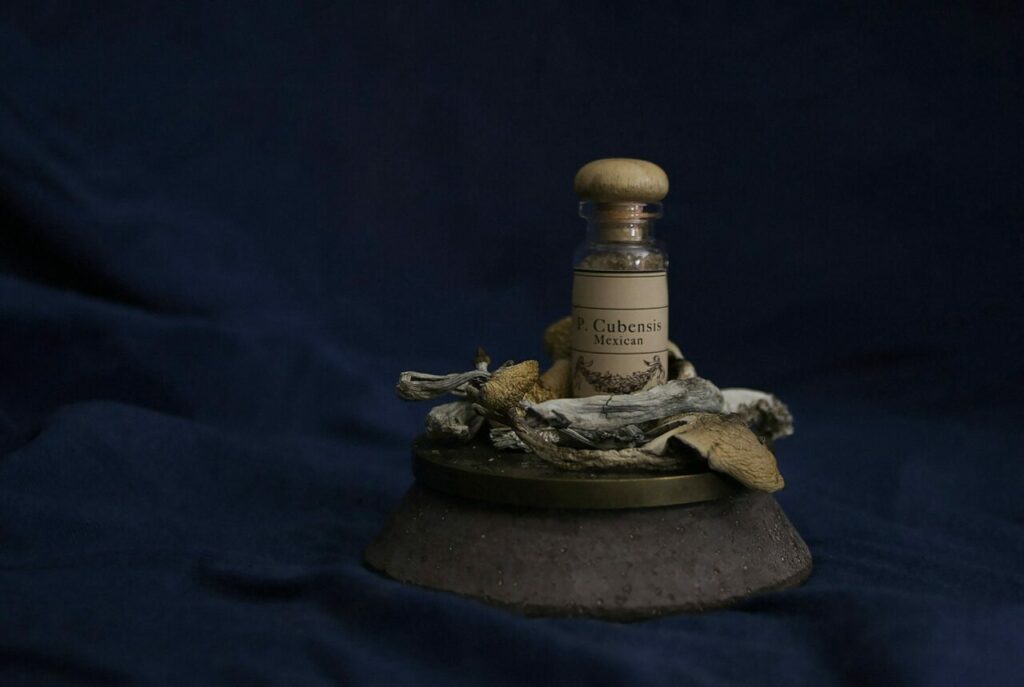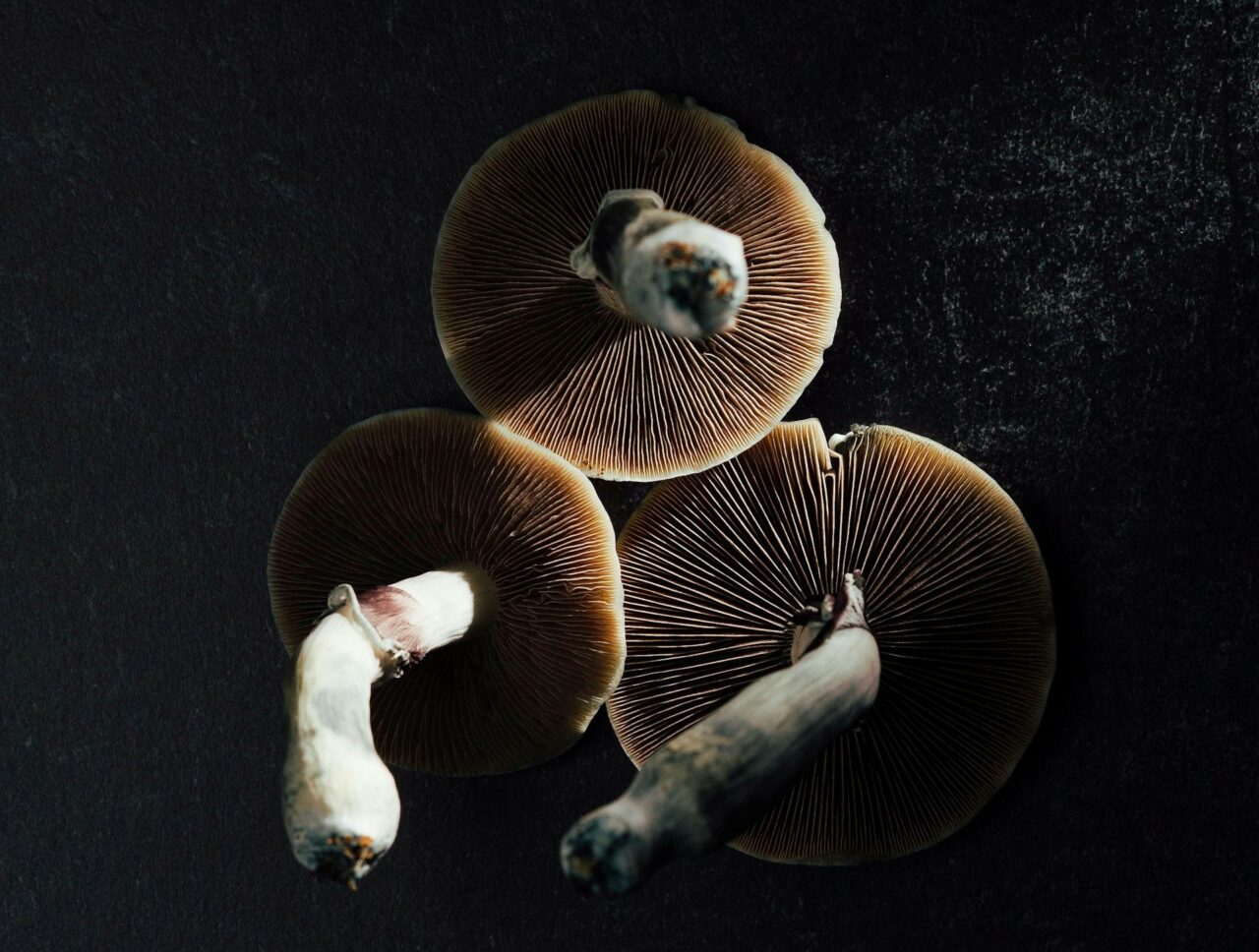As the fascination for natural magic mushrooms in Canada intensifies, lab-made psilocybin products are also gaining popularity. Researchers often favor these lab-produced products due to their precise dosage. However, they might be unaware that natural mushrooms can display greater potency than their lab-grown counterparts. Experts point out notable disparities between the two, including differences in potency.

Key Takeaways:
- More than 180 species of natural mushrooms provide various levels of potency, the effects of which can vary depending on the species, consumption method, how they are grown, and individual tolerance.
- Synthetic psilocybin, a lab-developed version of the organic compound, is produced in controlled settings to ensure uniformity and purity for clinical research, especially in the field of mental health treatments.
- The combined effects of multiple compounds in psychedelic mushrooms, such as psilocin and baeocystin, can create a more powerful and deep-seated experience than any single compound alone.
Emerging Market: Psychedelics in Various Forms
The demand for psilocybin mushrooms in Canada is accelerating, particularly for the treatment of specific mental health disorders such as OCD, depression, PTSD, and anxiety. In response to this growing interest, provincial governments are starting to contemplate decriminalizing their recreational use.
In 2020, Canada sanctioned limited medical use of these mushrooms under certain circumstances. Just a year ago, the federal government permitted certain terminally ill patients to use these substances to alleviate their symptoms.
These progressive steps have led to the emergence of synthetic psychedelics.
The Ongoing Debate
The continuous discourse over organic versus lab-made psychedelics revolves around safety, accessibility, and expense.
Many contend that natural psychedelics provide a more comprehensive and traditional experience. Conversely, advocates of lab-manufactured versions emphasize their suitability for medical use due to ease of standardization, guaranteed dosage control, and quality assurance.
While lab-made psychoactive substances could expand accessibility, there are ongoing concerns about potential drug monopolization. Critics warn this could result in less higher costs for users.
/wp:paragraph –>Grasping Psilocybin: A Comprehensive Look
Psilocybe cubensis, a kind of magic mushroom, is one of the myriad naturally present psychedelic substances accessible today. Recognized for their psychoactive properties, magic mushrooms appear in various strains such as Golden Teachers, Amazonian Cubensis, Blue Meanies, among others, with Psilocybe cubensis being the most prevalent family.
Comprehending the Psychedelic Mechanism
Psilocin, derived from this mushroom, metamorphoses into a different compound upon liver metabolization. This newly formed compound engages with the brain’s serotonin receptors, primarily the 5-HT2A receptor.
This receptor is pivotal in mood adjustment, cognitive operations, and perception. Its engagement with the new compound alters the standard functioning of serotonin pathways, leading to transformed visual and auditory perception, shifts in thought processes, and emotional states. This occurrence results in an elevated mood, augmented creativity, introspection, and the so-called “psychedelic” experiences.
Two Main Categories
| Natural | Found in over 180 fungi species, the potency varies depending on the mushroom species. Psilocybe cubensis is a common variety. The effects can differ based on ingestion methods, cultivation techniques, and individual tolerance. |
| Synthetic | Fabricated in labs and chemically identical to natural compounds. They are developed in controlled settings to guarantee consistency and purity. These are increasingly being explored for clinical uses, particularly in mental health treatment. |
Nature’s Offering vs. Science’s Invention: The Fundamental Differences
Natural variants of these drugs are discovered in certain magic mushroom species. Indigenous communities in North and South America have utilized these mushrooms in their rituals and ceremonies, viewing them as sacred or divine.
- Derived from plants and mushrooms
- Employed in ancient ceremonies and healing rituals
- The unique genetic composition of each strain influences its potency
On the other hand, the
A lab-concocted drug is These substances closely mimic the natural chemical structure of specific compounds. Expertly crafted by pharmaceutical professionals in controlled settings, these drugs, despite their similarities to natural ones, can alter the overall psychedelic experience.
- Formulated by experienced pharmaceutical experts
- New advances intended for medical usage
- Precise potency due to a regulated manufacturing process
Natural substances, due to their bioactive compounds, offer additional benefits. The concentrations of psilocybin and other compounds can vary among different types of mushrooms, leading to a range of effects.
Researcher Insights
Research conducted at Hebrew University revealed that psychedelic mushrooms have a more potent and enduring effect on synaptic plasticity than their synthetic counterparts. The researchers explored how the drug influenced mouse brain activity by observing changes in behavior and specific brain chemicals.
The study discovered that the extract reduced head twitches and promoted the formation of new brain connections, suggesting the mushroom extract could provide more benefits than a single compound.
Additionally, the researchers introduced the “entourage effect” concept. They described it as the combined impact of multiple compounds in psychedelic mushrooms potentially being more potent than the impact of individual compounds. In the case of mushrooms, psilocin, baeocystin, and other tryptamines may synergistically create a profound experience.
These supplementary chemicals are absent in lab-generated substances, which might result in slight differences in effects, even if the psychedelic content is the same.
Expert Opinions on the Supremacy of Nature
Consistently, research suggests that psilocybin, in any form, shows promise in treating various psychiatric disorders. A 2024 study examined the impacts of controlled substances on treatment-resistant depression patients and found a decrease in symptoms following the use of magic mushrooms.
When paired with other treatments, natural psychedelics may stimulate deeper emotional understanding and revelations during therapy, thus enhancing long-term results.
Additionally, researchers from the same university found that hallucinogenic mushrooms boost synaptic plasticity. They possess a distinct metabolic profile that affects oxidative stress and energy production pathways, unlike synthetic psychedelics.
Implications for the Market
The growing body of research on this subject may shape the views and buying behaviors of Canadians towards psychedelics. Early initiatives by Health Canada, especially the Special Access Program, are providing encouraging signals of potential legalization and a transformative impact on therapeutic practices. Psilocybin-assisted therapy may soon become a predominant treatment method.
In clinical trials and therapeutic settings, the preference for organic options is projected to rise. As the country progresses towards fully harnessing the benefits of organic psychedelics, substantial improvements in mental health treatments are likely on the horizon.
How to Safely Acquire Shrooms in Canada
- Through Section 56 Exemption: Health Canada recognizes that psilocybin may be an alternative treatment for patients with severe medical conditions. This exemption is part of the Controlled Drugs and Substances Act.
- Clinical Trials: Initial clinical trials have been approved to examine the drug’s efficacy in treating mental health illnesses. Participants must meet specific requirements and pass a physician’s screening.
- Online Market: Psilocybin capsules or edibles can be purchased from online vendors in Canada. However, it’s crucial to buy these products from reliable sources.
Experience the Power of Natural Compounds
Nature is brimming with marvels, including shrooms. Instead of opting for synthetic psychedelics, try the naturally potent magic mushrooms from Canada. They offer therapeutic benefits. Discover top-quality, naturally sourced shroom strains at Mushrooms Online Canada.
The shrooms that we have on sale exceed industry standards by maintaining their most natural and authentic composition in a dried form. Place your order now and enjoy convenient and discreet delivery right to your doorstep.
Frequently Asked Questions
What are baeocystin and norbaeocystin?
Both baeocystin and norbaeocystin are types of tryptamine, or indole alkaloids. They are chemically akin to psilocybin. These tryptamine derivatives act as secondary alkaloids in shrooms, contributing to the overall psychedelic experience, though to a smaller extent. Baeocystin and Norbaeocystin possess a similar chemical structure, but differ in their psychoactive effects.
Are capsules and edibles filled with organic dried mushrooms?
The variation in experience could depend on the source. Online Dispensaries offer products that are rich in organic components, which facilitate the full entourage effect. On the other hand, synthetic components in capsule form are frequently employed in clinical trials and healthcare centers.
Do natural psychedelics foster more profound experiences?
It’s crucial to note that expecting a profound experience from a natural psychedelic might actually help bring about that very experience. After all, our expectations, being part of the ‘set’, can influence the trajectory of the journey. Natural psychedelics are often linked with ceremonial traditions, and these ritualistic settings can lead to uniquely fulfilling experiences. These experiences are markedly different in many aspects from those encountered in clinic sessions that involve synthetic compounds.





